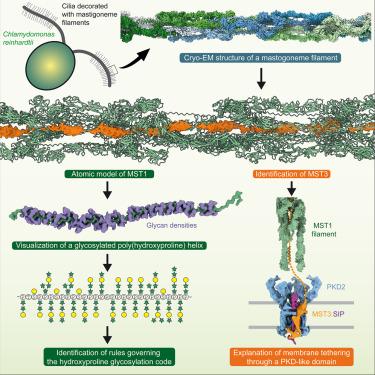Cell ( IF 64.5 ) Pub Date : 2024-03-28 , DOI: 10.1016/j.cell.2024.03.005 Jin Dai , Meisheng Ma , Qingwei Niu , Robyn J. Eisert , Xiangli Wang , Poulomi Das , Karl F. Lechtreck , Susan K. Dutcher , Rui Zhang , Alan Brown

|
Hydroxyproline-rich glycoproteins (HRGPs) are a ubiquitous class of protein in the extracellular matrices and cell walls of plants and algae, yet little is known of their native structures or interactions. Here, we used electron cryomicroscopy (cryo-EM) to determine the structure of the hydroxyproline-rich mastigoneme, an extracellular filament isolated from the cilia of the alga Chlamydomonas reinhardtii. The structure demonstrates that mastigonemes are formed from two HRGPs (a filament of MST1 wrapped around a single copy of MST3) that both have hyperglycosylated poly(hydroxyproline) helices. Within the helices, O-linked glycosylation of the hydroxyproline residues and O-galactosylation of interspersed serine residues create a carbohydrate casing. Analysis of the associated glycans reveals how the pattern of hydroxyproline repetition determines the type and extent of glycosylation. MST3 possesses a PKD2-like transmembrane domain that forms a heteromeric polycystin-like cation channel with PKD2 and SIP, explaining how mastigonemes are tethered to ciliary membranes.
中文翻译:

Mastigoneme结构揭示了对天然富含羟脯氨酸螺旋的O-连接糖基化密码的见解
富含羟脯氨酸的糖蛋白(HRGP)是植物和藻类的细胞外基质和细胞壁中普遍存在的一类蛋白质,但对其天然结构或相互作用知之甚少。在这里,我们使用电子冷冻显微镜 (cryo-EM) 来确定富含羟脯氨酸的鞭毛丝的结构,这是一种从藻类莱茵衣藻的纤毛中分离出来的细胞外丝。该结构表明,鞭丝体由两个 HRGP(一条 MST1 细丝包裹在一个 MST3 拷贝周围)形成,两者都具有高糖基化的聚(羟脯氨酸)螺旋。在螺旋内,羟脯氨酸残基的O-连接糖基化和散布的丝氨酸残基的O-半乳糖基化形成碳水化合物外壳。对相关聚糖的分析揭示了羟脯氨酸重复模式如何决定糖基化的类型和程度。 MST3 具有类似 PKD2 的跨膜结构域,可与 PKD2 和 SIP 形成异聚多囊蛋白样阳离子通道,解释了鞭毛体如何与纤毛膜相连。



























 京公网安备 11010802027423号
京公网安备 11010802027423号